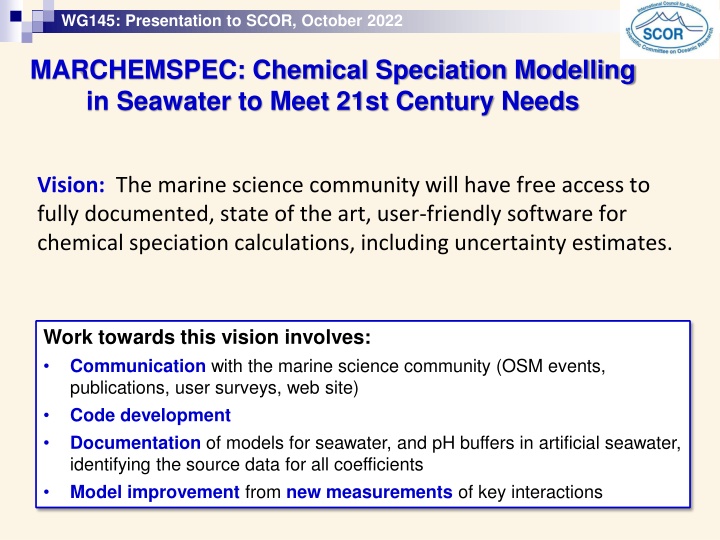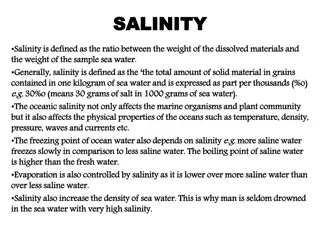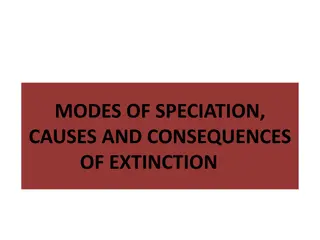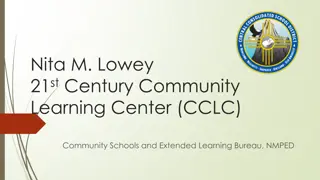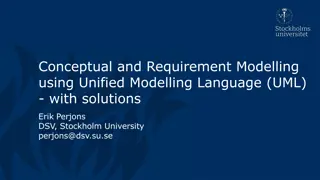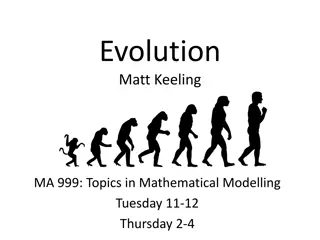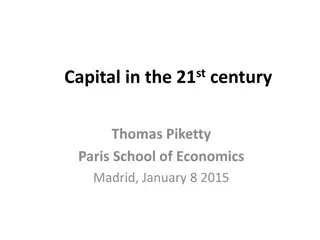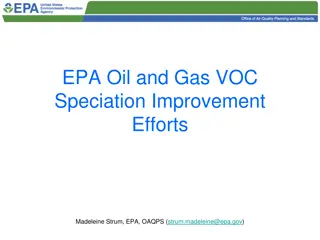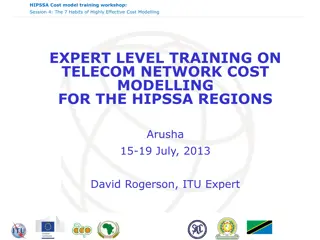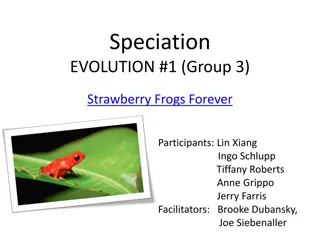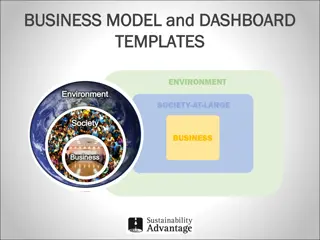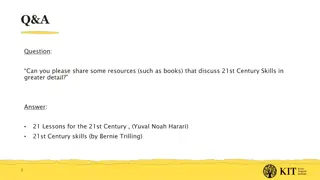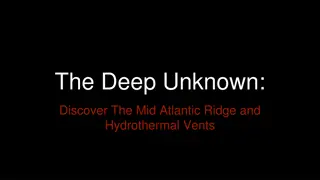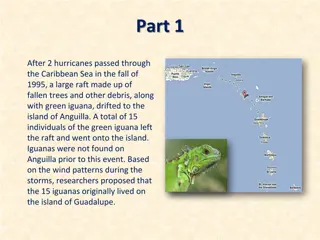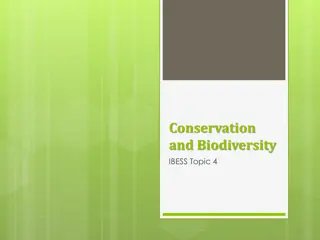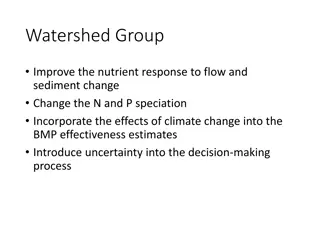Chemical Speciation Modelling in Seawater for 21st Century Needs
Chemical speciation modelling in seawater is advancing to meet the needs of the marine science community in the 21st century. The vision is to provide free access to user-friendly software for calculations with uncertainty estimates. This involves communication with the community, code development, documentation, model improvement, and integrating new measurements. The timeline includes software releases, code development milestones, and planned workshops. Completed and planned publications highlight the progress in this area.
Download Presentation

Please find below an Image/Link to download the presentation.
The content on the website is provided AS IS for your information and personal use only. It may not be sold, licensed, or shared on other websites without obtaining consent from the author.If you encounter any issues during the download, it is possible that the publisher has removed the file from their server.
You are allowed to download the files provided on this website for personal or commercial use, subject to the condition that they are used lawfully. All files are the property of their respective owners.
The content on the website is provided AS IS for your information and personal use only. It may not be sold, licensed, or shared on other websites without obtaining consent from the author.
E N D
Presentation Transcript
WG145: Presentation to SCOR, October 2022 MARCHEMSPEC: Chemical Speciation Modelling in Seawater to Meet 21st Century Needs Vision: The marine science community will have free access to fully documented, state of the art, user-friendly software for chemical speciation calculations, including uncertainty estimates. Work towards this vision involves: Communication with the marine science community (OSM events, publications, user surveys, web site) Code development Documentation of models for seawater, and pH buffers in artificial seawater, identifying the source data for all coefficients Model improvement from new measurements of key interactions
WG145: Presentation to SCOR, October 2022 Timeline SOFTWARE RELEASE Meeting no. 5 Meeting no. 2 Meeting no. 3 Meeting no. 1 Meeting no. 4 2022 2021 2015 2018 2019 2020 2016 2017 Add trace metals to the model Draft modelling software on web, OSM event OSM town hall, user survey Project plan, expanded collaboration Survey of user needs, NERC/NSF project: code development, and measurements at NIST Other measurements : GEOMAR complete; NMIJ complete; University of Bristol complete; City University of Hong Kong complete; PTB complete Current status: Communication: presentations in 2022 at OSM; Oceans in a High CO2 World; BIPM metrology workshop: updates distributed via our website and emails. We plan an in-person Workshop on the use of the model at Woods Hole in June 2023 (coinciding with the Ocean Carbon and Biogeochemistry Summer Workshop) Code development: in progress for late 2022/early 2023 initial release. Documentation: complete for pH buffer in artificial seawater, standard seawater and GEOTRACES core elements. New measurements:contributions from multiple institutions received, and ongoing. Model improvement: work on uncertainties, and identifying key systems for study, at UEA
WG145: Presentation to SCOR, October 2022 Completed and planned publications Published D.R. Turner, E.P. Achterberg,C-T.A. Chen, S.L. Clegg, V. Hatje, M.T. Maldonado, S. Sander, C.M.G. van den Berg and M. Wells (2016). Towards a quality-controlled and accessible Pitzer model for seawater and related systems, Frontiers in Marine Science, 3, 139. doi: 10.3389/fmars.2016.00139 P. Lodeiro, D.R. Turner, E.P. Achterberg, F.K.A. Gregson, J.P. Reid and S.L. Clegg (2021). Solid-Liquid Equilibria in Aqueous Solutions of Tris, Tris-NaCI, Tris-TrisHCl, and Tris-(TrisH)2SO4 at Temperatures from 5 to 45 C. Journal of Chemical and Engineering Data, 66, 437-455. doi: 10.1021/acs.jced.0c00744 M.P. Humphreys, J.F. Waters, D.R. Turner, A,G. Dickson and S.L. Clegg (2022) Chemical Speciation Models Based Upon the Pitzer Activity Coefficient Equations, and Including the Propagation of Uncertainties: Artificial Seawater from 0 to 45 o C. Marine Chemistry, 244, 104095. doi: http://dx.doi.org/10.1016/j.marchem.2022.104095 S.L. Clegg, M.P. Humphreys, J.F. Waters, D.R. Turner, and A.G. Dickson (2022) Chemical Speciation Models Based Upon the Pitzer Activity Coefficient Equations, Including the Propagation of Uncertainties. II. Tris Buffers in Artificial Seawater at 25 o C, and the Marine 'Total' pH Scale. Marine Chemistry, 244, 104096. doi: 10.1016/j.marchem.2022.104096 Submitted S.L. Clegg, J.F. Waters, D.R. Turner, and A.G. Dickson. Chemical Speciation Models Based Upon the Pitzer Activity Coefficient Equations, Including the Propagation of Uncertainties. III. Standard Seawater From The Freezing Point to 45 oC, Including Acid-Base Equilibria, submitted to Marine Chemistry. (Favourable reviews received.) Planned Chemical Speciation Models Based Upon the Pitzer Activity Coefficient Equations, Including the Propagation of Uncertainties. IV. The GEOTRACES core elements. (SI completed contains values of all selected equilibrium constants and other information.) Best practice for chemical speciation modelling of seawater and related systems. Papers describing results of experiments to support model development (experiments are ongoing).
WG145: Presentation to SCOR, October 2022 Completion of Terms of Reference We are on target to complete our Terms of Reference by the end of the year, and respectfully request that we continue as a SCOR WG until then, so that the software release can be clearly identified as a SCOR product. The benefits are: A clear SCOR contribution to the development of marine science. SCOR sponsorship will help to ensure acceptance and use by the marine science community. The Future The 2022/2023 software release represents a valuable first step: we have already identified the work that is needed to improve the description of key interactions. The Joint Committee on Seawater and two of its sponsoring organisations (SCOR and IAPSO) have agreed to create a new Taskgroup on Chemical Speciation to continue the development of the speciation models after WG145 has been disbanded. A decision from the third sponsor, IAPWS, is expected during the autumn.
